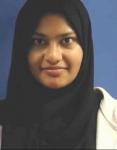Below is a summary of the abstract you submitted. Presenting author(s) is shown in bold.
If any changes need to be made, you can modify the abstract or change the authors.
You can also download a .docx version of this abstract.
If there are any problems, please email Dan at dar78@pitt.edu and he'll take care of them!
This abstract was last modified on March 31, 2025 at 10:41 p.m..

Bacteriophages are the most abundant organisms in the biosphere, and harbor potential as therapeutics for bacterial infections. The isolation and characterization of bacteriophages provide valuable insights into complex evolutionary relationships between phages and their host bacteria. Arthrobacter phages Babushka and DanHam62 were isolated by enrichment on Arthrobacter globiformis B-2979 from moist soil collected in Long Island New York as part of the Science Education Alliance-Phage Hunters Advancing Genomics and Evolutionary Science (SEA-PHAGES) program. The genomes of Babushka and DanHam62 were sequenced at the University of Pittsburgh and found to be 38380 bp and 38467 bp long respectively with average GC content of 66% with 12bp 3' Sticky Overhang ends. Both phage were placed into cluster AS3 and share 92% overall nucleotide similarity and 85% gene content similarity. While closely related, other members of AS3 are more similar to each. Phage DanHam62 has 99% nucleotide sequence similarity to phage Atlantica and Babushka has 93% nucleotide similarity to phage Leona. The genome organization for AS3 phages is similar within the cluster with structural genes on the left arm followed by a central region of reverse strand transcribed genes containing a putative tyrosine recombinase, immunity repressor, and others DNA binding proteins. The right arm of the genome is forward strand transcribed and contains a series of DNA metabolism genes and other genes with no known function. Like other cluster AS3 phage, DanHam62 and Babushka are predicted to be temperate based on the identification of putative tyrosine integrase and repressor genes. Based on this prediction we are attempting to isolate stable lysogens of both phage.





